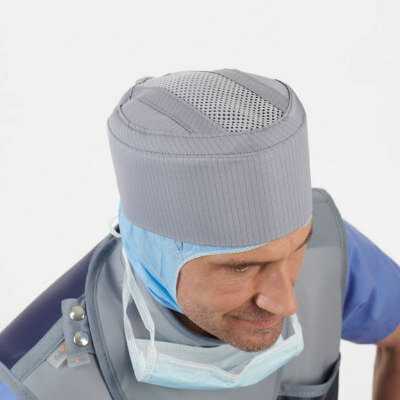New AI Solution Simplifies Prostate MRI Analysis
|
By MedImaging International staff writers Posted on 17 Mar 2021 |

Image: The qp-Prostate suite dashboard (Photo courtesy of Quibim)
A novel artificial intelligence (AI) algorithm processes magnetic resonance imaging (MRI) data in order to increase diagnostic accuracy and detect prostate cancer (PC) earlier.
The Quibim (Valencia, Spain) qp-Prostate suite is a non-invasive imaging tool that uses MRI data and advanced computer models to investigate prostate anatomy in extreme detail. The suite automatically detects, identifies, and segments each prostate region, including the transitional zone, peripheral zone, and the seminal vesicles, as well as other areas defined in the PI-RADS v2.1 guidelines. It also automatically runs processing steps, such as arterial input function (AIF) selection, motion correction, and spatial smoothing algorithms in order to improve image quality and minimize heterogeneity across vendors.
The web-based DICOM viewer enables users to configure and modify the processing steps. Reporting is also accelerated with qp-Prostate's automated rules engine, allowing an end-to-end workflow. Reports can be sent to the picture archive and communication system (PACS) instantaneously and synced with a patient's folder, so that complete medical information is available to radiologists at any time. Users can edit the standard PI-RADS v2.1 templates and re-launch any analysis if deemed necessary. The tool works with both biparametric (T2+DWI and T2+DCE) or multiparametric (T2+DWI+DCE) MRI exams.
“We challenged ourselves to build the world's finest AI platform for prostate imaging, to help increase diagnostic precision as a tireless companion to the clinician, helping transform the men's care journey,” said Angel Alberich Bayarri, MD, CEO of Quibim. “Instead of analyzing the prostate as a whole, the solution can segment the prostate's transitional zone, peripheral zone and seminal vesicles, as well as other regions to extract clinically meaningful quantitative information from the MRI examination as a potential aid for early and accurate clinicians' diagnosis.”
“MRI is the perfect modality for prostate evaluation, however only 5% of radiologists are trained to interpret prostate MRI data,” said Professor Luis Martí-Bonmatí, MD, co-founder of Quibim. “qp-Prostate shortens the learning curve and reduces the workload for radiologists, potentially increasing productivity by reducing image reading time, and generates more meaningful insights for patient diagnosis and monitoring.”
Early detection of PC is an important, but challenging task for oncologists, as early-stage disease is asymptomatic. Current diagnostic tools, such as prostate-specific antigen (PSA) markers in blood have limitations, and may result in patients undergoing invasive biopsies or even unnecessary surgeries.
Related Links:
Quibim
The Quibim (Valencia, Spain) qp-Prostate suite is a non-invasive imaging tool that uses MRI data and advanced computer models to investigate prostate anatomy in extreme detail. The suite automatically detects, identifies, and segments each prostate region, including the transitional zone, peripheral zone, and the seminal vesicles, as well as other areas defined in the PI-RADS v2.1 guidelines. It also automatically runs processing steps, such as arterial input function (AIF) selection, motion correction, and spatial smoothing algorithms in order to improve image quality and minimize heterogeneity across vendors.
The web-based DICOM viewer enables users to configure and modify the processing steps. Reporting is also accelerated with qp-Prostate's automated rules engine, allowing an end-to-end workflow. Reports can be sent to the picture archive and communication system (PACS) instantaneously and synced with a patient's folder, so that complete medical information is available to radiologists at any time. Users can edit the standard PI-RADS v2.1 templates and re-launch any analysis if deemed necessary. The tool works with both biparametric (T2+DWI and T2+DCE) or multiparametric (T2+DWI+DCE) MRI exams.
“We challenged ourselves to build the world's finest AI platform for prostate imaging, to help increase diagnostic precision as a tireless companion to the clinician, helping transform the men's care journey,” said Angel Alberich Bayarri, MD, CEO of Quibim. “Instead of analyzing the prostate as a whole, the solution can segment the prostate's transitional zone, peripheral zone and seminal vesicles, as well as other regions to extract clinically meaningful quantitative information from the MRI examination as a potential aid for early and accurate clinicians' diagnosis.”
“MRI is the perfect modality for prostate evaluation, however only 5% of radiologists are trained to interpret prostate MRI data,” said Professor Luis Martí-Bonmatí, MD, co-founder of Quibim. “qp-Prostate shortens the learning curve and reduces the workload for radiologists, potentially increasing productivity by reducing image reading time, and generates more meaningful insights for patient diagnosis and monitoring.”
Early detection of PC is an important, but challenging task for oncologists, as early-stage disease is asymptomatic. Current diagnostic tools, such as prostate-specific antigen (PSA) markers in blood have limitations, and may result in patients undergoing invasive biopsies or even unnecessary surgeries.
Related Links:
Quibim
Latest MRI News
- PET/MRI Improves Diagnostic Accuracy for Prostate Cancer Patients
- Next Generation MR-Guided Focused Ultrasound Ushers In Future of Incisionless Neurosurgery
- Two-Part MRI Scan Detects Prostate Cancer More Quickly without Compromising Diagnostic Quality
- World’s Most Powerful MRI Machine Images Living Brain with Unrivaled Clarity
- New Whole-Body Imaging Technology Makes It Possible to View Inflammation on MRI Scan
- Combining Prostate MRI with Blood Test Can Avoid Unnecessary Prostate Biopsies
- New Treatment Combines MRI and Ultrasound to Control Prostate Cancer without Serious Side Effects
- MRI Improves Diagnosis and Treatment of Prostate Cancer
- Combined PET-MRI Scan Improves Treatment for Early Breast Cancer Patients
- 4D MRI Could Improve Clinical Assessment of Heart Blood Flow Abnormalities
- MRI-Guided Focused Ultrasound Therapy Shows Promise in Treating Prostate Cancer
- AI-Based MRI Tool Outperforms Current Brain Tumor Diagnosis Methods
- DW-MRI Lights up Small Ovarian Lesions like Light Bulbs
- Abbreviated Breast MRI Effective for High-Risk Screening without Compromising Diagnostic Accuracy
- New MRI Method Detects Alzheimer’s Earlier in People without Clinical Signs
- MRI Monitoring Reduces Mortality in Women at High Risk of BRCA1 Breast Cancer
Channels
Radiography
view channel
Novel Breast Imaging System Proves As Effective As Mammography
Breast cancer remains the most frequently diagnosed cancer among women. It is projected that one in eight women will be diagnosed with breast cancer during her lifetime, and one in 42 women who turn 50... Read more
AI Assistance Improves Breast-Cancer Screening by Reducing False Positives
Radiologists typically detect one case of cancer for every 200 mammograms reviewed. However, these evaluations often result in false positives, leading to unnecessary patient recalls for additional testing,... Read moreUltrasound
view channel
Deep Learning Advances Super-Resolution Ultrasound Imaging
Ultrasound localization microscopy (ULM) is an advanced imaging technique that offers high-resolution visualization of microvascular structures. It employs microbubbles, FDA-approved contrast agents, injected... Read more
Novel Ultrasound-Launched Targeted Nanoparticle Eliminates Biofilm and Bacterial Infection
Biofilms, formed by bacteria aggregating into dense communities for protection against harsh environmental conditions, are a significant contributor to various infectious diseases. Biofilms frequently... Read moreNuclear Medicine
view channel
New SPECT/CT Technique Could Change Imaging Practices and Increase Patient Access
The development of lead-212 (212Pb)-PSMA–based targeted alpha therapy (TAT) is garnering significant interest in treating patients with metastatic castration-resistant prostate cancer. The imaging of 212Pb,... Read moreNew Radiotheranostic System Detects and Treats Ovarian Cancer Noninvasively
Ovarian cancer is the most lethal gynecological cancer, with less than a 30% five-year survival rate for those diagnosed in late stages. Despite surgery and platinum-based chemotherapy being the standard... Read more
AI System Automatically and Reliably Detects Cardiac Amyloidosis Using Scintigraphy Imaging
Cardiac amyloidosis, a condition characterized by the buildup of abnormal protein deposits (amyloids) in the heart muscle, severely affects heart function and can lead to heart failure or death without... Read moreGeneral/Advanced Imaging
view channel
New AI Method Captures Uncertainty in Medical Images
In the field of biomedicine, segmentation is the process of annotating pixels from an important structure in medical images, such as organs or cells. Artificial Intelligence (AI) models are utilized to... Read more.jpg)
CT Coronary Angiography Reduces Need for Invasive Tests to Diagnose Coronary Artery Disease
Coronary artery disease (CAD), one of the leading causes of death worldwide, involves the narrowing of coronary arteries due to atherosclerosis, resulting in insufficient blood flow to the heart muscle.... Read more
Novel Blood Test Could Reduce Need for PET Imaging of Patients with Alzheimer’s
Alzheimer's disease (AD), a condition marked by cognitive decline and the presence of beta-amyloid (Aβ) plaques and neurofibrillary tangles in the brain, poses diagnostic challenges. Amyloid positron emission... Read more.jpg)
CT-Based Deep Learning Algorithm Accurately Differentiates Benign From Malignant Vertebral Fractures
The rise in the aging population is expected to result in a corresponding increase in the prevalence of vertebral fractures which can cause back pain or neurologic compromise, leading to impaired function... Read moreImaging IT
view channel
New Google Cloud Medical Imaging Suite Makes Imaging Healthcare Data More Accessible
Medical imaging is a critical tool used to diagnose patients, and there are billions of medical images scanned globally each year. Imaging data accounts for about 90% of all healthcare data1 and, until... Read more
Global AI in Medical Diagnostics Market to Be Driven by Demand for Image Recognition in Radiology
The global artificial intelligence (AI) in medical diagnostics market is expanding with early disease detection being one of its key applications and image recognition becoming a compelling consumer proposition... Read moreIndustry News
view channel
Bayer and Google Partner on New AI Product for Radiologists
Medical imaging data comprises around 90% of all healthcare data, and it is a highly complex and rich clinical data modality and serves as a vital tool for diagnosing patients. Each year, billions of medical... Read more




















